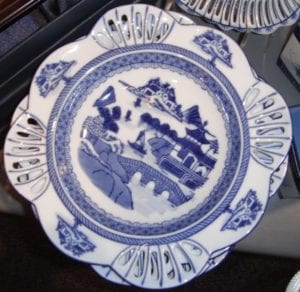Art & Antiques by Dr. Lori by Dr. Lori Verderame
The highly collectible ceramics called Cantonware is a cobalt blue and white porcelain first produced in the port city of Canton (Guangzhou), China. Cantonware is known by various names associated with its sea-trade history including: Chinese export porcelain, ballast ware china, China trade porcelain, etc. Named for the port city of Canton, Cantonware was enjoyed prominence for its secret ceramic recipe and closely-guarded kiln production techniques.
Since the 1600s, Cantonware china was traded from China to ports worldwide. It was heavy enough to act as the ballast of a ship situated down low to help keep the ship stable.
Made in the Chinese province of Ching-Te Chen and decorated in enameling studios in Canton, Cantonware was introduced to American collectors by a Rhode Island merchant. This businessman received a shipment of Cantonware as early as the late 1700s, after which Cantonware was used by many Colonial Americans. Used as their everyday china, Cantonware was found in circa 1790s inventory records of Mount Vernon, the Virginia home of President George and Martha Washington located near Washington, DC.
When the Revolutionary war ended and China trade became popular, Cantonware came to the New Republic. From 1784 to circa 1850, about 2 million pieces of Cantonware were exported to North America. By the late 1830s to 1860, Cantonware fell out of favor as a result of the Opium wars when China lost territory and power to the European powers of Great Britain and France. The Opium Wars weakened trade practices and spiked market prices associated with Cantonware.
Early Cantonware from circa 1784-1810 featured hand-painted decorations and well-built porcelain bodies. Later Cantonware lacked the quality of first period Cantonware. It can be identified by today’s collectors by its drab appearance, faulty clay form, and lack of precise decoration.

Cantonware pattern from the collection of President George and Martha Washington; on view at historic Mount Vernon in Mount Vernon, VA, near Washington, DC.
Cantonware is highly recognizable for its blue/white color scheme and hand-painted subjects such as Asian tea houses, pagodas, foot bridges, sail boats, meandering waterways, mountains, and figures.
Asian imagery and borders of lattice or criss-cross and scallops, swags, clouds, diagonal lines, or wave patterns are also common to Cantonware. By the late 19th Century, Cantonware was marked with the word “China” written or stamped on each piece.
While blue/white porcelains are common and Cantonware was popular so reproductions occurred. Portuguese reproductions of Cantonware were commonly marked “Mottahedah” on the underside of the base.
Major museums boast collections of Cantonware including the Lowe Art Museum in Coral Gables, FL, Metropolitan Museum of Art in New York, NY, and Museum of the American China Trade in Milton, MA, to name a few.
Dr. Lori Verderame is an author, award-winning TV personality and Ph.D. Antiques Appraiser on the HISTORY channel. With a Ph.D. from Penn State University and vast experience appraising art, antiques, and artifacts worldwide for museums and collectors, Dr. Verderame is the director of www.DrLoriV.com, a resource for identifying art and artifacts.


